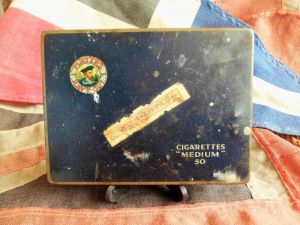Players Navy Cut Tobacco Cigarettes' Medium 50 Tin
Price: NZ$43.42
Code: Bh991
Players Navy Cut Tobacco Cigarettes’ Medium 50 Manufactured by Imperial Tobacco Company Of New Zealand Ltd. Used condition see all the images. The size of the tin is 5 3/4” or 145 mm long x 4 1/4” or 110mm wide x 5/8” or 17mm deep.
Nice little tin with a maritime flavour, could be used for many things or even reinstated to its original use. On your desk for those little Knick knacks, business cards or stationary items. Whatever you use it for it will be an attractive addition to your décor.
The Navy Cut Tobacco was a brand of cigarettes manufactured by the Imperial Tobacco Group formerly John Player & Sons in Nottingham, England. Particularly popular in Britain and Germany in the late 19th century and early part of the 20th century, the packet boasted a distinctive logo of a smoking sailor in a ‘Navy Cut’ cap.
The phrase “Navy Cut” was supposed to have originated from the habit of sailors taking a mixture of tobacco leaves and binding them with string or twine. The tobacco would then mature under pressure and the sailor could then dispense the tobacco by slicing off a “cut”.
A large part of the early branding centered around the image of the sailor known as “Hero” because of the name on his hat band. It was first used in 1883 and the lifebuoy was added five years later. The sailor images were an 1891 artists concept registered for Chester-based William Parkins and Co for their “Jack Glory” brand. Behind the sailor are two ships. The one on the left is thought to be HMS Britannia and the one on the right HMS Dreadnought or maybe HMS Hero. As time went by the image of the sailor changed it sometimes had a beard and other times was clean shaven. In 1927 “Hero” was standardized on a 1905 version. As part of the 1927 marketing campaign John Player and Sons commissioned an oil painting Head of a Sailor by Arthur David McCormick.
Originally available in various sized hinged tins, the packaging gradually changed to a cardboard container with a four sided sliding tray like the classic matchbox design. In the early 1950’s this design evolved into the flip top design we see today.



